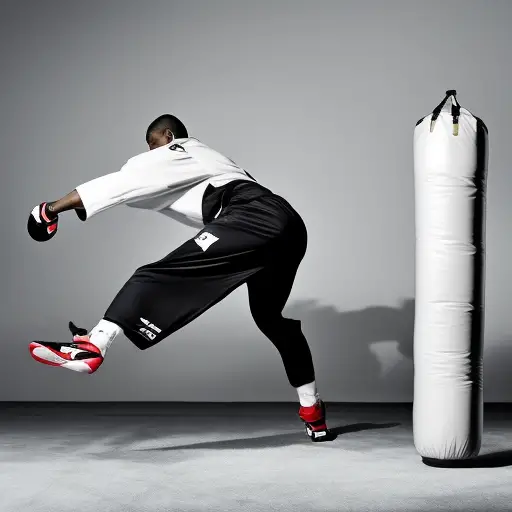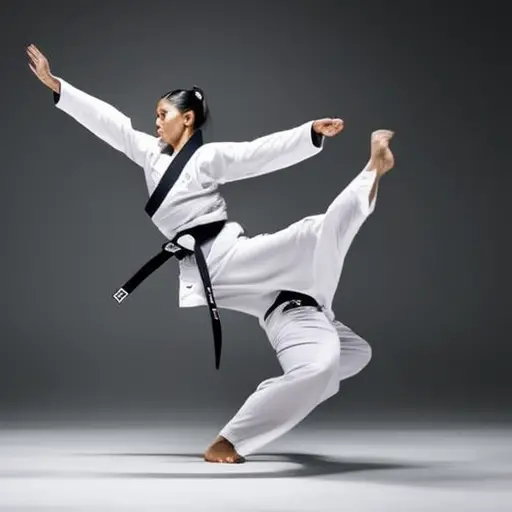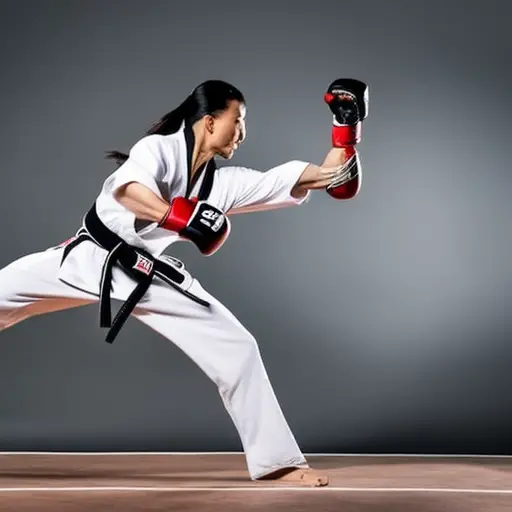Deciphering Taekwondo Terminology

Deciphering the intricate language of Taekwondo is a pursuit that requires both dedication and a deep understanding of its origins and techniques. In this article, we embark on a disciplined exploration of the terminology that underpins this martial art, unraveling its complex meanings and uncovering the significance behind each movement and gesture.
By delving into the depths of Taekwondo’s vocabulary, we aim to equip practitioners and enthusiasts alike with the knowledge and precision necessary to navigate this ancient practice with confidence and expertise.
The Origins of Taekwondo Terminology
In the exploration of the origins of Taekwondo terminology, a deep understanding of the historical and cultural influences is crucial. The analysis of the origins of Taekwondo terminology involves a careful examination of its linguistic evolution over time. Taekwondo, a Korean martial art, has its roots in ancient Korean combat practices and has been shaped by various historical events and cultural influences.
The origins of Taekwondo terminology can be traced back to the Korean language. The Korean language, known for its complex grammar and unique phonetic system, has played a significant role in shaping the terminology used in Taekwondo. The analysis of the origins of Taekwondo terminology reveals that it has evolved over the centuries, incorporating words and phrases from various sources.
One of the key influences on Taekwondo terminology is the Chinese language. Due to the close proximity and historical interactions between Korea and China, many Chinese words and characters were incorporated into the Korean language, including those used in Taekwondo terminology. The linguistic evolution of Taekwondo terminology also reflects the influence of other martial arts, such as Japanese Karate, which was introduced to Korea during the Japanese occupation in the early 20th century.
Understanding the Basics: Taekwondo Stances
Proper stances are fundamental in Taekwondo as they provide stability, balance, and power in executing techniques. There are several common stances in Taekwondo, each serving a different purpose.
These stances include:
- Parallel stance
- Front stance
- Back stance
- Horse stance
- Cat stance
Each of these stances has its own unique characteristics and applications within Taekwondo. Mastering these stances is essential for practitioners to develop a strong foundation in the martial art.
Importance of Proper Stance
Mastering the correct stances is essential for achieving success in Taekwondo. Proper alignment, balance, and stability are the foundations of any taekwondo stance. In order to execute powerful kicks and strikes, it is crucial to maintain a proper stance throughout the practice.
Proper alignment refers to positioning the body in a way that ensures optimal power and efficiency. Balance is key to maintaining stability and preventing falls or injuries during movements. Stability is achieved by distributing weight evenly and grounding oneself firmly to the floor. These elements work together to create a solid foundation for executing techniques effectively.
Understanding the importance of these aspects will prepare practitioners for the subsequent section, which will delve into the common taekwondo stances and their specific characteristics.
Common Taekwondo Stances
Once practitioners grasp the importance of proper alignment, balance, and stability in Taekwondo stances, they can move on to understanding the specific characteristics of common Taekwondo stances.
These stances serve as the foundation for executing various techniques and kicks in Taekwondo. The most common stances include the parallel stance, front stance, back stance, and horse stance.
The parallel stance, with feet shoulder-width apart and parallel to each other, provides a balanced and stable base for both offensive and defensive movements.
The front stance, with one foot forward and the other foot back, offers stability and power for forward attacks.
The back stance, with a majority of the body weight on the back leg, allows for quick changes in direction.
Lastly, the horse stance, with feet wider than shoulder-width apart and knees bent, provides stability and strength for executing powerful kicks.
Proper execution of these stances is crucial for effective and efficient Taekwondo techniques and kicks.
Unveiling the Meanings of Taekwondo Kicks
Understanding the significance of Taekwondo kicks is crucial for practitioners seeking to enhance their technique and performance in the martial art. Taekwondo is renowned for its dynamic and powerful kicks, which are not only effective in combat but also contribute to overall physical fitness and flexibility. Exploring different kicking techniques is essential to mastering this aspect of Taekwondo.
There are various types of kicks in Taekwondo, including front kicks, roundhouse kicks, side kicks, and back kicks. Each kick serves a specific purpose and requires proper execution to maximize its effectiveness. Front kicks, for example, are commonly used for long-range attacks, while side kicks are effective for breaking boards or delivering powerful strikes to the opponent’s midsection. It is important for practitioners to understand the mechanics of each kick and practice them diligently to develop precision and power.
In addition to exploring different kicking techniques, it is equally important to be aware of common mistakes to avoid in Taekwondo kicks. Common errors include improper balance, lack of flexibility, and incorrect foot placement. These mistakes can hinder the execution and effectiveness of the kicks, making them less powerful and precise. Practitioners should pay close attention to their posture, weight distribution, and body alignment to ensure proper technique.
Understanding the significance of Taekwondo kicks and mastering their execution can greatly improve a practitioner’s performance in this martial art. By exploring different kicking techniques and avoiding common mistakes, practitioners can enhance their technique and power, ultimately becoming more skilled and proficient in Taekwondo.
Now, let’s transition into breaking down Taekwondo strikes and punches.
Breaking Down Taekwondo Strikes and Punches
Regularly practicing and refining the techniques of Taekwondo strikes and punches is vital for practitioners to achieve precision and effectiveness in their martial art skills. Taekwondo offers a wide range of striking techniques that can be used in various situations.
Here are some key points to consider when breaking down Taekwondo strikes and punches:
-
Punches: Taekwondo punches are typically executed with a straight and powerful motion. Some effective punching techniques include:
-
Jab: A quick and straight punch, usually aimed at the opponent’s face.
-
Cross: A powerful punch thrown with the rear hand, crossing the body.
-
Hook: A curved punch targeting the side of the opponent’s head or body.
-
Strikes: Taekwondo strikes involve the use of different body parts to deliver force. Here are a few breaking technique variations:
-
Knife Hand Strike: A strike executed with the edge of the hand, aimed at vulnerable areas like the neck or throat.
-
Back Fist Strike: A strike performed with the back of the fist, commonly used for close-range attacks.
-
Elbow Strike: A strike using the point of the elbow, effective for close-quarters combat.
-
Effective Striking Techniques: To maximize the effectiveness of strikes and punches, practitioners should focus on proper technique, speed, and accuracy. Generating power from the legs and core is essential for delivering strong strikes. Additionally, maintaining a stable stance and following through with the strike can enhance its impact.
Exploring Taekwondo Forms and Patterns
When it comes to exploring Taekwondo forms and patterns, understanding the meaning behind each movement is crucial. Each form is meticulously crafted to represent a specific concept or principle, making it essential for practitioners to grasp the symbolism behind their actions.
Moreover, memorization plays a significant role in this aspect of Taekwondo, as it allows practitioners to perform the forms with precision and fluidity.
Over time, these forms have evolved, adapting to the changing needs and philosophies within the martial art, reflecting the dynamic nature of Taekwondo.
Meaning Behind Movements
Analyzing the symbolism and significance of each movement in Taekwondo forms and patterns reveals the depth of martial arts tradition and philosophy.
Taekwondo forms, also known as patterns or kata, are a series of choreographed movements that simulate real combat scenarios. Each movement within these forms carries a specific meaning and purpose, reflecting the values and principles of Taekwondo.
Understanding the symbolism behind these movements is essential to fully grasp the cultural significance of Taekwondo. For example, the various stances and strikes represent different aspects of combat and self-defense techniques.
Additionally, the fluidity and gracefulness of the movements embody the harmony between mind and body, emphasizing the importance of discipline and control. Furthermore, the patterns often pay homage to the history and heritage of Taekwondo, incorporating elements from Korean culture.
Importance of Memorization
The practitioner’s ability to memorize the intricate sequences of Taekwondo forms and patterns, as well as their underlying meanings, is crucial for the development and mastery of this martial art. Repetition plays a significant role in the process of memorization. By repeatedly practicing these forms and patterns, practitioners can internalize the movements and sequences, allowing for more fluid and precise execution. Additionally, mnemonic techniques can greatly aid in memorization. These techniques involve using associations, visualizations, or acronyms to help remember the specific order and details of each form or pattern. Mnemonic techniques not only enhance memory retention but also provide a mental framework for understanding the purpose and application of each movement. The table below illustrates the benefits of repetition and mnemonic techniques in the memorization process:
| Importance of Repetition | Benefits of Mnemonic Techniques |
|---|---|
| Reinforces muscle memory | Enhances memory retention |
| Ensures accurate execution | Provides mental framework |
| Improves speed and timing | Facilitates understanding |
| Builds confidence | Helps recall under pressure |
Evolution of Forms
One significant aspect of the practice and study of Taekwondo is the dynamic evolution of its forms and patterns, as well as the influence of various martial arts styles and philosophies that have shaped its development.
Over the years, Taekwondo forms, known as poomsae, have undergone evolutionary changes to adapt to the needs and preferences of practitioners. These changes have allowed for the inclusion of more dynamic and athletic movements, reflecting the emphasis on agility and speed in modern Taekwondo.
Moreover, modern influences from other martial arts disciplines, such as Kung Fu and Karate, have also contributed to the evolution of Taekwondo forms, bringing in new techniques and variations.
The continuous evolution of forms in Taekwondo highlights the art’s ability to adapt and grow, keeping it relevant and exciting for practitioners worldwide.
- Introduction of new kicking techniques
- Incorporation of acrobatic movements
- Integration of self-defense scenarios
Mastering Taekwondo Blocks and Defenses
Developing precise and effective taekwondo blocks and defenses is crucial for practitioners to enhance their overall defensive skills. Mastering taekwondo sparring techniques and effective taekwondo counterattacks require a strong foundation in blocking and defense. By understanding and practicing various taekwondo blocks and defenses, practitioners can effectively protect themselves from incoming attacks and create opportunities for counterattacks.
To illustrate the importance of mastering taekwondo blocks and defenses, let’s take a look at a simple three-column, three-row table:
| Block/Defense | Technique | Purpose |
|---|---|---|
| High Block | Raise forearm to block incoming high attacks | Defend against strikes aimed at the head or upper body |
| Low Block | Lower forearm to block incoming low attacks | Defend against strikes aimed at the lower body or legs |
| Knifehand Block | Extend hand with fingers together to block incoming strikes | Defend against attacks aimed at sensitive areas such as the neck or throat |
These are just a few examples of the many taekwondo blocks and defenses that practitioners must master. By practicing these techniques, taekwondo practitioners can develop the necessary skills to defend themselves effectively and counterattack with precision and confidence.
The Language of Taekwondo: Essential Vocabulary
Understanding the essential vocabulary of taekwondo is crucial for practitioners to effectively communicate and comprehend the principles and techniques of this martial art. As with any specialized discipline, taekwondo has its own set of terms and phrases that are used to describe various aspects of the practice.
Here are some key vocabulary words that every taekwondo student should know:
-
Taekwondo Belt System:
-
White Belt: The starting point for all beginners
-
Black Belt: The highest level of achievement in taekwondo
-
Color Belts: The various ranks between white and black belts, each representing different levels of proficiency
-
Taekwondo Training Equipment:
-
Dobok: The traditional uniform worn by taekwondo practitioners
-
Sparring Gear: Protective equipment used during sparring sessions, including headgear, chest protectors, and shin guards
-
Breaking Boards: Wooden boards used to test the power and accuracy of strikes
By familiarizing themselves with these terms, students can enhance their understanding of taekwondo and effectively communicate with their instructors and fellow practitioners. Moreover, knowing the appropriate terminology helps create a sense of unity and respect within the taekwondo community.
Understanding the essential vocabulary is just the first step on the journey of advancing in taekwondo. Transitioning into the subsequent section, we will explore the significance of belt ranks and terminology within the taekwondo community.
Advancing in Taekwondo: Belt Ranks and Terminology
To progress in taekwondo and gain higher levels of proficiency, practitioners must navigate through the belt ranks and familiarize themselves with the corresponding terminology. Belt progression is an important aspect of taekwondo, as it represents the journey and growth of a practitioner.
In most taekwondo schools, the belt ranks follow a color system, starting from white and progressing towards black.
Each belt rank has its own set of testing requirements, which include demonstrating various techniques, forms, sparring skills, and knowledge of taekwondo philosophy. As practitioners move up the belt ranks, the testing requirements become more challenging, reflecting their increasing skill level and understanding of the martial art.
The belt ranks in taekwondo also come with specific terminology. For example, the first belt rank, white belt, is referred to as ‘hayan geup’ in Korean. Each subsequent belt rank has its own Korean term, such as ‘dehong’ for red belt or ‘yudanja’ for black belt. Learning and using the correct terminology is important to maintain the tradition and respect for the art of taekwondo.
Frequently Asked Questions
What Are the Different Types of Taekwondo Competitions and How Do They Relate to the Terminology Used in the Sport?
There are various types of taekwondo competitions, each with its own rules and regulations. In these competitions, taekwondo terminology is used to describe techniques, scoring, and strategies employed by participants to achieve victory.
Are There Any Specific Breathing Techniques That Are Incorporated Into Taekwondo Movements and Forms?
Proper breathing techniques in taekwondo movements play a crucial role in enhancing performance and maintaining control. Understanding the importance of consistent and controlled breathing is essential for executing powerful and precise techniques in taekwondo forms.
How Does Understanding the Meaning Behind Taekwondo Terminology Enhance the Practitioner’s Overall Performance in the Sport?
Understanding the meaning behind taekwondo terminology is crucial in training as it enhances communication and connection in sparring. It enables practitioners to execute techniques with precision and clarity, elevating their overall performance in the sport.
Are There Any Cultural or Historical Influences on the Development of Taekwondo Terminology?
Cultural and historical influences have played a significant role in the development of taekwondo terminology. The rich cultural traditions and historical events have shaped the language used in taekwondo, reflecting its origins and values.
What Are Some Common Misconceptions or Misunderstandings About Taekwondo Terminology That Beginners Often Have?
Common misconceptions about taekwondo terminology that beginners often have include the belief that it is simply a set of random words, when in fact, it has specific meanings and serves as a vital part of the martial art’s tradition and culture.
Conclusion
In conclusion, delving into the world of taekwondo terminology has been a journey of discovery and understanding. From the origins of the language to the intricate meanings behind each stance, kick, and strike, we have unraveled the secrets of this ancient martial art.
As we navigate the complexities of taekwondo, we realize that there is much more to learn and explore. So, let us continue on this path of knowledge and discipline, embracing the irony that the more we know, the more we realize how much there is still left to decipher.





